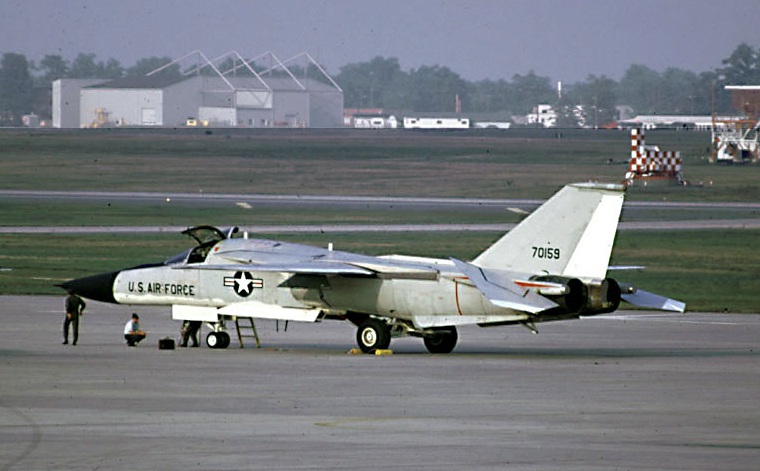
13 July 1968: The first production General Dynamics FB-111A supersonic strategic bomber successfully completed a 30-minute maiden flight at Carswell Air Force Base, Fort Worth, Texas. The FB-111A differed from the F-111A fighter bomber with the substitution of a larger wing, originally designed for the F-111B, giving the bomber a 7 foot (2.134 meter) increase in wingspan. The landing gear was strengthened, the bomb bay enlarged, and it had more powerful engines.

The airplane’s very long nose earned the nickname “Aardvark,” but this did not become official until 1996.
67-0159 was delivered to the U.S. Air Force 4 September 1968 and assigned to the Air Force Flight Test Center, Edwards Air Force Base, California. (The first six production airplanes were used for flight testing.)
67-0159 was later converted to the F-111G configuration. In 1980 it was sent to the Sacramento Air Logistics Center to test weapons modifications and received a spectacular white and orange paint scheme. It was retired in 1990. 67-0159 is in the collection of the National Museum of the United States Air Force. It is on loan and now on display at the Aerospace Museum of California, Sacramento, California.
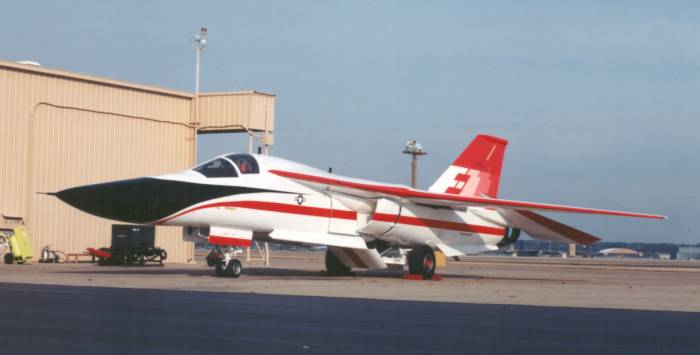

The wings of the FB-111A have a total area of 550 square feet (51.10 square meters). When fully extended, the wings’ leading edges are swept aft to 16.0°. The angle of incidence at the root is +1° and -3° at the tip. There is 1.0° dihedral.
The Aardvark’s empty weight is 47,481 pounds (21,537 kilograms). Normal maximum takeoff weight is 116,115 pounds (52,669 kilograms), and the maximum overload takeoff weight is or 119,243 pounds (54,088 kilograms).

The FB-111A has an average cruise speed of 415–442 knots (478–509 miles per hour/769-819 kilometers per hour), depending on the mission profile. It’s maximum speed at 50,000 feet (15,240 meters) is 1,262 knots (1,452 miles per hour/2,337 kilometers per hour)—Mach 2.20. The bomber’s service ceiling varies from 50,390 feet to 56,380 feet (15,359–17,185 meters), again, depending on the mission profile. The maximum combat range is 4,920 nautical miles (5,662 statute miles/9,112 kilometers). The airplane can carry as many as six 600 gallon (2,271 liter) external tanks on underwing pylons. This gives the Aardvark a maximum ferry range of 4,313 nautical miles (4,963 statute miles/7,988 kilometers).
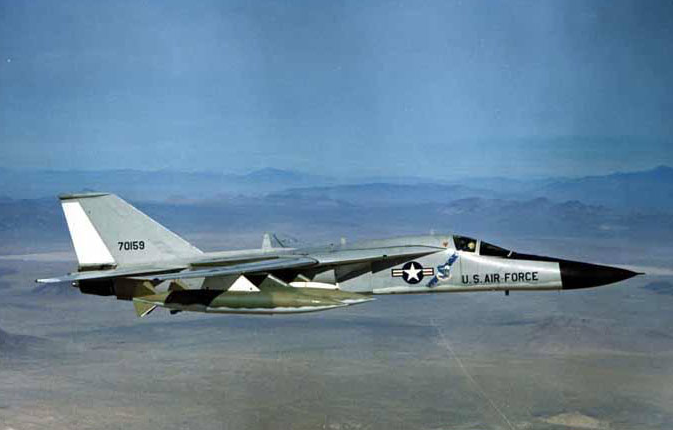
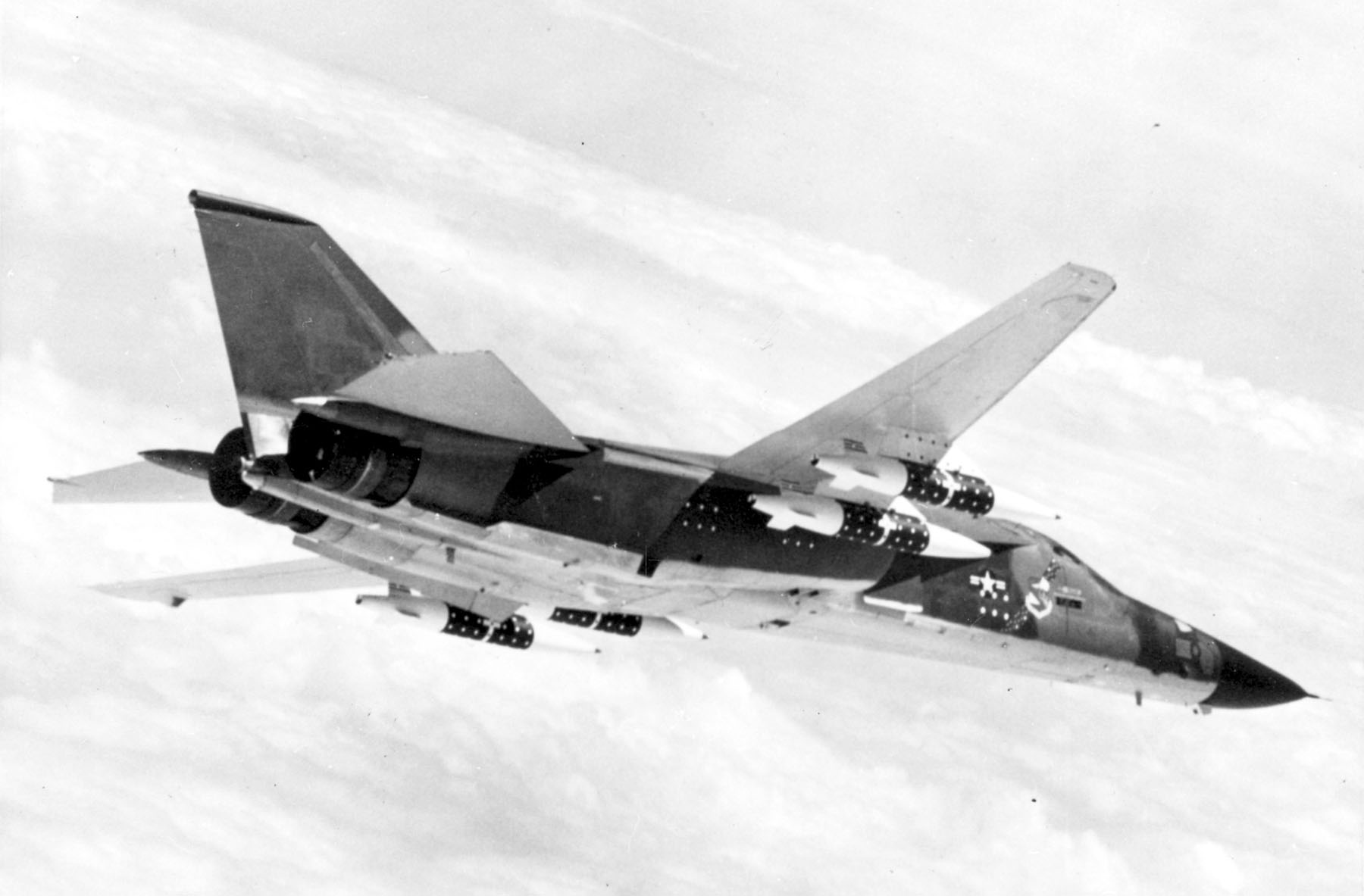
The FB-111A could carry weapons in an internal bomb bay or on underwing hardpoints. It could be armed with up to 37,500 pounds (17,010 kilograms) of conventional bombs; or six AGM-69A Short Range Attack Missiles (SRAM). The Aardvark could carry maximum of six nuclear weapons (B-43, B-57 or B-61).
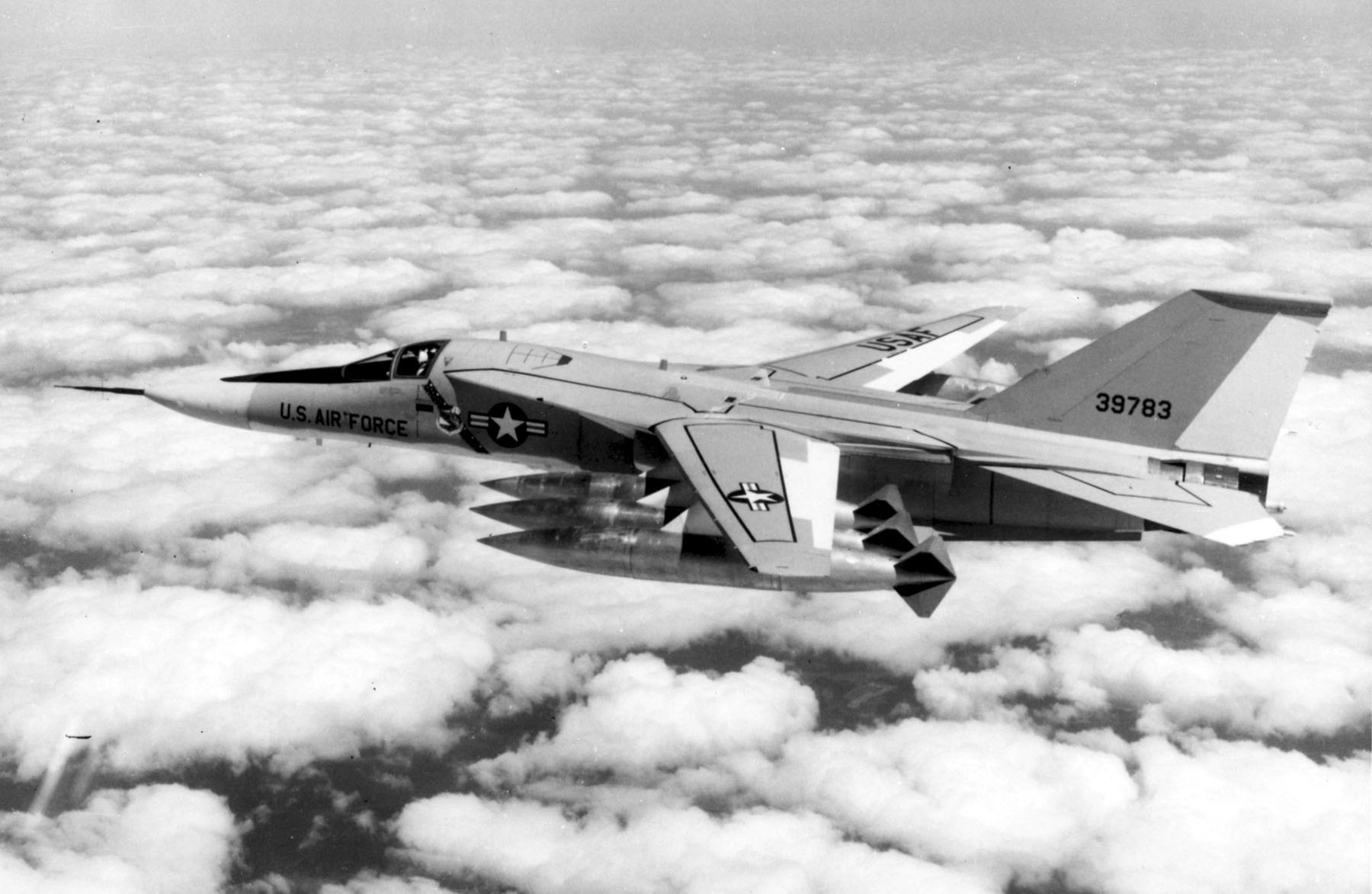
In addition to a prototype (63-9783, which was converted from the last production F-111A) General Dynamics built 76 FB-111A strategic bombers. With the introduction of the Rockwell B-1B Lancer, the FB-111As remaining in service were converted to F-111G tactical fighter bombers. They were retired by 2003.
The Royal Australian Air Force bought 15 of the F-111Gs. By 2007, these had also been taken out of service.
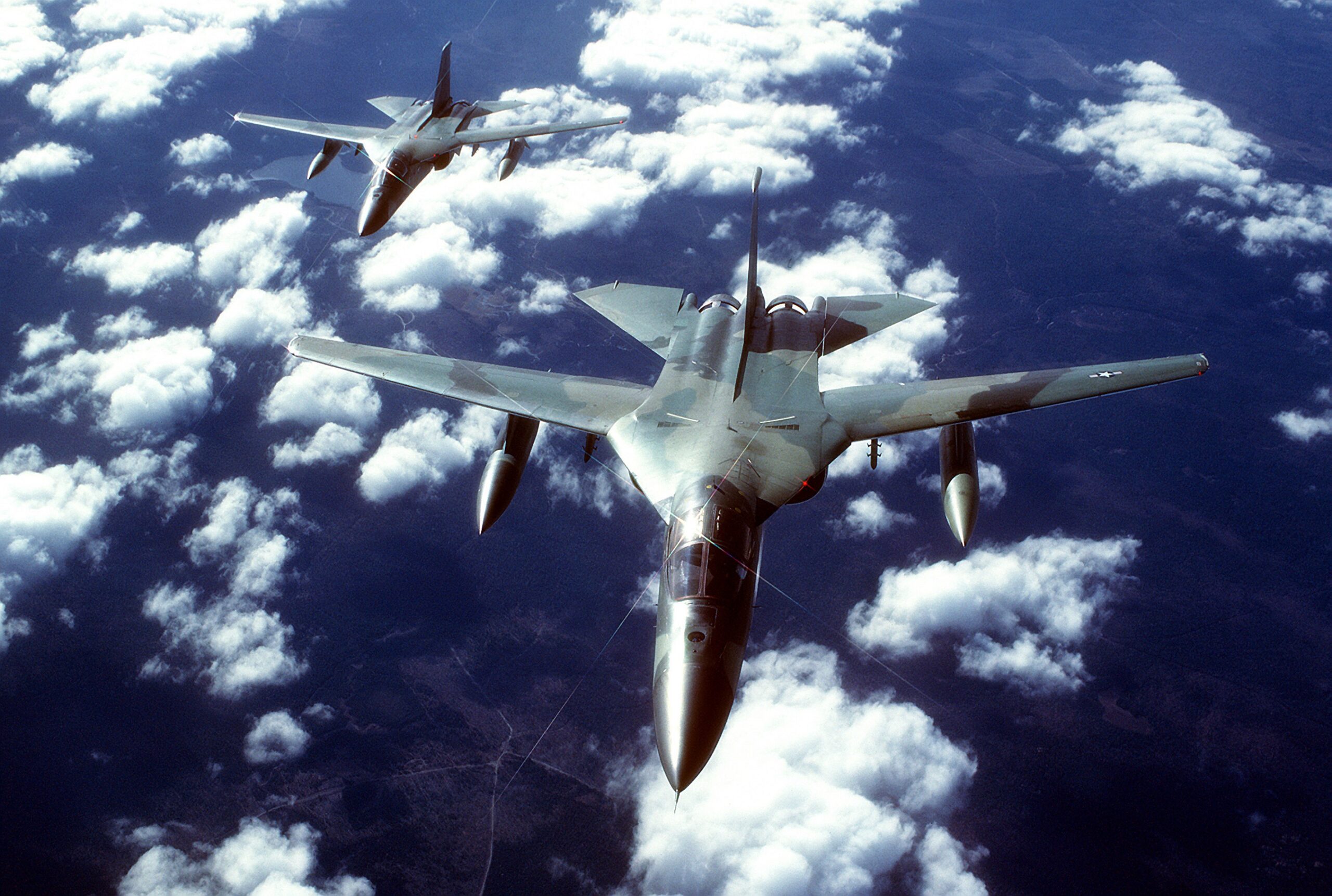
© 2018, Bryan R. Swopes
Excellent article.
Thank you. I’m glad that you liked it.
Brion, your articles frequently take me down the rabbit hole!
I have new respect for the Aardvark, having now read of it’s combat performance in Libya and Iraq.
https://en.wikipedia.org/wiki/General_Dynamics_F-111_Aardvark#Operational_history
Thanks, John. Every article I write teaches me something new. 🙂
Nice article. Two edit suggestions though. The FB-111A/F-111G was retired in 1993 rather than 2003. Also, the Aardvark was officially named as such on its retirement in July 1996.
I’m wondering why you didn’t mention the EF-111 Raven. You usually include the variants in your postings.
Interesting, I was at McClellan when they performed depot maintenance on them, saw a bunch coming in and out.
Strange that the combat range is higher than the ferry range with external tank
This question probably warrants its own article, but how can ordinance be mounted on variable-sweep wings? The wings must become fixed in one position, and if so, at what angle? Or can the mounts change their angle somehow?
– Question from a recovering engineer
Some of the pylons pivot with the wings to keep them facing fwd. The outermost pylons were fixed. Most often there were no pylons attached to the outer hardpoints because it limited the jet to sub sonic speeds.
I had wondered the same thing. After a little investigating…
Minimum sweep 16 degrees
Maximum sweep 72.5 degrees
Each wing had provisions for 4 pylons
The innermost pair could pivot with wing sweep to keep pylons parallel to the fuselage.
The outer two were fixed in orientation for optimum alignment during 26 degrees of wing sweep. Based on what I read, it seems like the outermost station was never used on any version. The third station out from the fuselage was occasionally used by FB-111’s for an external fuel tank. If used, the sweep was limited to 26 degrees which corresponded to an initial cruise setting. Take-off was at 16 degrees sweep and shifted to 26 degrees once airborne. Therefore there was 10 degrees of skewed alignment during the take-off phase. Research suggests it was not common practice to fly with a fuel tank on the 3rd Station.
I remember seeing an F-111 on static display at an air show at Andrews AFB summer 1968. I thought it was so cool. It still is.
Well I went through a lot of material and after hitting ‘send’ I check out another source. I found a photograph of an F-111 with all 4 pylons loaded with bombs.
https://scholar.afit.edu/cgi/viewcontent.cgi?article=1029&context=docs
Obviously the sources I read were incorrect on the usage.
I also forgot to mention that the two outboard pylons could be jettisoned to allow subsequent configuration to full sweep.
Please pardon my error. Thanks.
Thanks really appreciate
I was stationed at Pease AFB, NH when the first FB-111A arrived. The Wing Commander did the fuel dump and burn demonstration as he made a pass down the Runway. As we weren’t aware of that feature, everyone was thinking the plane was on fire! I was at Pease from Dec 1970 to Nov 1972.
The photo in this article that you identify as FB-111A 67-163 is actually F-111A 66-0011, which was assigned to the FB-111 test program. You can tell the aircraft in the photo is not an FB-111 because of the F-111A engine splitter plate that’s visible in the photo. Only the first FB-111A had this feature.
Thank you, Greg. You may be absolutely correct, however the source of the image, the National Museum of the United States Air Force, identifies it as 67-153. See https://www.nationalmuseum.af.mil/Upcoming/Photos/igphoto/2000548466/ In fact, the caption in my post was a straight cut-and-paste from the USAF image caption. The identifying numbers on the vertical fin have either been painted out, or airbrushed. A second photograph, also identified as 67-163, does not show the splitter vane that you mentioned. https://www.nationalmuseum.af.mil/Upcoming/Photos/igphoto/2000548465/ TDiA did find an image of 66-0011 in the R.A. Scholefield collection which DOES have the splitter vane. Accordingly, I am going to change my caption. I also found another image of 67-153, which I have added to the post. Thank you for bringing this to my attention.